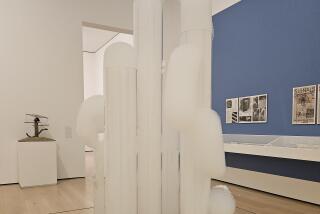Laguna to Honor ‘Forgotten Genius’
Described by those who knew him as a forgotten genius with an eccentric personality, Stanislav Szukalski was his own biggest obstacle to artistic acclaim.
A Polish nationalist and staunch rebel, Szukalski protested Germany’s invasion of his homeland, fought art critics, curators and gallery owners and refused to join art movements that would have furthered his reputation but categorized his work.
For most of his life he did not live as a career artist. Reluctant to sell his paintings and sculptures, he survived by drawing maps for a Southern California aerospace firm..
It’s no wonder that his first retrospective, “Struggle: the Art of Szukalski,” will be presented posthumously, opening Sunday at the Laguna Art Museum.
“Here is this artist who barked off everything he thought, and that offended a lot of people,” said Glenn Bray. He and his wife, Lena Zwalve, own the artist’s estate, and Bray is executor of Archives Szukalski, based in Los Angeles.
“He was his own worst enemy. It took me a while to realize that he would not be famous in his lifetime because of his brashness.”
The artist lived in Burbank since the 1940s, where he died 13 years ago at age 93 virtually unrecognized in the United States, even though he was highly regarded in Poland during his early career.
After he came to live permanently in the United States, he barely made enough money to pay rent, much less to rent a studio. Still he created a large body of work. The retrospective contains more than 25 bronze sculptures, drawings, scrapbooks and sketch books filled with studies and illustrations.
Those who admire his works say Szukalski fused the movement and energy of Futurism, the emotion of Impressionism and the geometric configurations of Cubism into a single, poetic form. His art reflects his studies in anthropology and mythology. He tried to draw connections between different cultures, particularly the Greeks, the Meso-Americans and his Polish heritage.
“Szukalski created these sculptures where the figures were crosses between animals and people, and he put these different cultural references into his artwork for this unifying theory of a better world,” said Tyler Stallings, curator of the exhibition.
“His works have a sense of illustration. They’re like storybook drawings that allow people to understand the narrative of his pieces.”
Stallings sees the Szukalski exhibition as part of a resurgence in the public’s hunger for representational works, such as Norman Rockwell’s current show.
“Szukalski has an amazing technical and illustrative skill much the way Rockwell did,” he said.
His work is compelling, powerful and often verges on the confrontational, Bray said.
“I was only 18 when I saw it. I was grabbed by it. It hooked me. And I want to hook others into it,” he said.
“You can’t deny a bronze sculpture. You have to face it,” said Bray, affectionately referring to the artist by his nickname, “Stas.” “I want to draw people into his work the way I was drawn into it.”
A collector by nature, Bray stumbled upon Szukalski’s works in art books on the dusty shelves of a used bookstore. Little did he know he and Szukalski lived in the same neighborhood and frequented the same bookstores.
“Who would have thought that a famed Polish artist was living in your backyard,” Bray said.
The two became close friends.
Because Szukalski never had enough money to have his work cast in bronze--he made plaster molds only--Bray took on the task of having them properly cast.
His molds were meant to be small replicas of monolithic monuments, said Stallings, curator of exhibitions at the Laguna Art Museum.
“He envisioned [them] for huge public monuments in recreation parks and plazas with inverted pyramids surrounded by water,” said Stallings.
During the ‘20s and ‘30s, his bronzes won him recognition from the Polish government, which honored him in 1936 with commissions for large works. Most of these were destroyed by the Nazis, melted down for military use.
Szukalski fled Poland in the late 1930s for the United States. Throughout his life he traveled between the U.S. and Poland visiting or living in Chicago and the Los Angeles area.
His vision was a unified world, not the war-torn one he had experienced. Without commissions, he continued to make bronzes and offer them to nations such as France as gestures of good will.
The continual acts of rebellion only contributed to his obscurity, a situation his friends hope to remedy. One well-placed friend is George DiCaprio, an alternative comics artist who named his son after Leonardo da Vinci. The show is underwritten by the son, actor Leonardo DiCaprio, and his father, who befriended Szukalski through Bray.
Through these admirers Szukalski’s reputation continues to grow.
“It’s amazing that an artist of this caliber and talent could go unrecognized,” Stallings said.
“I’d never heard of this artist, yet I’m blown away by the work. . . . It feels like discovering a secret treasure. There’s so much work, it’s so beautiful, but it’s so odd and quirky.
“And the treasure of his ideas, they’re so complicated and so complex. You don’t find a lot of artists working that way anymore.”
EXHIBITION SCHEDULE
“Struggle: the Art of Szukalski” opens Sunday. Hours: Daily, except Wednesdays and Monday holidays, 11 a.m.-5 p.m. $3-$8. Lecture by curator Tyler Stallings, Nov. 16, 7:30 p.m. Laguna Art Museum, 307 Cliff Drive, Laguna Beach. (949) 494-8971.
More to Read
The biggest entertainment stories
Get our big stories about Hollywood, film, television, music, arts, culture and more right in your inbox as soon as they publish.
You may occasionally receive promotional content from the Los Angeles Times.










